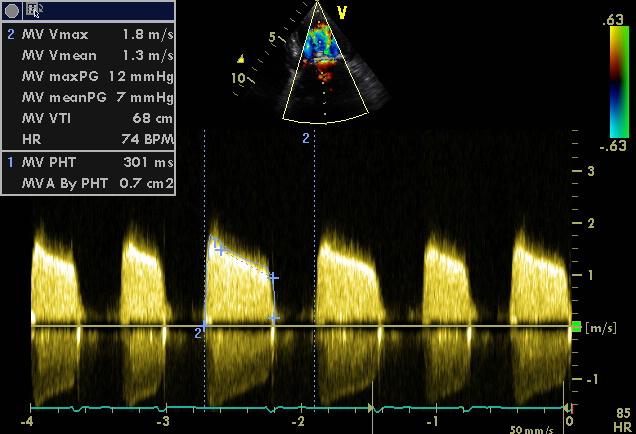Mitral Stenosis: Difference between revisions
(Created page with "==Quantification of mitral valve stenosis== {| class="wikitable" cellpadding="0" cellspacing="0" border="0" width="500px" |- ! !Slight !Moderate !Severe |- !PGmean |align="...") |
No edit summary |
||
| Line 1: | Line 1: | ||
==Quantification of mitral valve stenosis== | ==Quantification of mitral valve stenosis<cite>1</cite>== | ||
{| class="wikitable" cellpadding="0" cellspacing="0" border="0" width="500px" | {| class="wikitable" cellpadding="0" cellspacing="0" border="0" width="500px" | ||
|- | |- | ||
| Line 27: | Line 27: | ||
{| class="wikitable" cellpadding="0" cellspacing="0" border="0" | {| class="wikitable" cellpadding="0" cellspacing="0" border="0" | ||
|- | |- | ||
|[[Image:MS01.jpg | |[[Image:MS01.jpg]] | ||
|- | |- | ||
!Moderate / severe MS | !Moderate / severe MS | ||
|} | |} | ||
Various techniques can be used to estimate the severity of a mitral valve stenosis. | |||
The peak pressure is unreliable for assessing the severity of mitral valve stenosis. Also, the pressure differential is strongly influenced by the heart rate. A high heart rate will greatly increase the pressure difference due to the strongly reduced duration of diastole. For heart rates between 60 - 90/min , the average gradient is estimated by "tracing" of the CW signal across the mitral. | |||
==Pressure half-time== | |||
{| class="wikitable" cellpadding="0" cellspacing="0" border="0" | |||
|- | |||
|By using an empirical formula the mitral valve area can be calculated using: MVA = 220/PHT. | |||
|- | |||
|bgcolor="#FFFFFF" align="center"|[[Image:MVPHT.png]] | |||
|} | |||
===Pitfalls:=== | |||
In any situation where the LV diastolic pressure rises rapidly (AOI, non-compliant LV, myocardial ischemia) will give an underestimation of the severity of mitral valve stenosis. | |||
Immediately after balloon dilatation of the mitral valve, the method unreliable PHT | |||
Tachycardia at which the A-top merges with the E-top or boezemflutter which flutter waves the E-wave deformation may overestimate the incidence of mitral stenosis. | |||
Heart rates of between 60 and 90/min give best results | |||
Click [http://csecho.ca/cardiomath/?eqnHD=echo&eqnDisp=mvsmgh here] for Wilkins score (also called Mitral Valvuloplasty score) | |||
==References== | ==References== | ||
<biblio> | <biblio> | ||
#1 pmid=20435783 | #1 pmid=20435783 | ||
#2 pmid=3190958 | |||
</biblio> | </biblio> | ||
Revision as of 22:57, 9 December 2013
Quantification of mitral valve stenosis[1]
| Slight | Moderate | Severe | |
|---|---|---|---|
| PGmean | <5mmHg | 5-10mmHg | >10mmHg |
| PHT | <90m/s | 90-150m/s | >150m/s |
| MVA | >1.5cm2 | 1.5-1cm2 | <1cm2 |
Click here to calculate MVA by PHT

|
| Moderate / severe MS |
|---|
Various techniques can be used to estimate the severity of a mitral valve stenosis.
The peak pressure is unreliable for assessing the severity of mitral valve stenosis. Also, the pressure differential is strongly influenced by the heart rate. A high heart rate will greatly increase the pressure difference due to the strongly reduced duration of diastole. For heart rates between 60 - 90/min , the average gradient is estimated by "tracing" of the CW signal across the mitral.
Pressure half-time
| By using an empirical formula the mitral valve area can be calculated using: MVA = 220/PHT. |

|
Pitfalls:
In any situation where the LV diastolic pressure rises rapidly (AOI, non-compliant LV, myocardial ischemia) will give an underestimation of the severity of mitral valve stenosis. Immediately after balloon dilatation of the mitral valve, the method unreliable PHT Tachycardia at which the A-top merges with the E-top or boezemflutter which flutter waves the E-wave deformation may overestimate the incidence of mitral stenosis. Heart rates of between 60 and 90/min give best results
Click here for Wilkins score (also called Mitral Valvuloplasty score)
References
- Lancellotti P, Moura L, Pierard LA, Agricola E, Popescu BA, Tribouilloy C, Hagendorff A, Monin JL, Badano L, Zamorano JL, and European Association of Echocardiography. European Association of Echocardiography recommendations for the assessment of valvular regurgitation. Part 2: mitral and tricuspid regurgitation (native valve disease). Eur J Echocardiogr. 2010 May;11(4):307-32. DOI:10.1093/ejechocard/jeq031 |
- Wilkins GT, Weyman AE, Abascal VM, Block PC, and Palacios IF. Percutaneous balloon dilatation of the mitral valve: an analysis of echocardiographic variables related to outcome and the mechanism of dilatation. Br Heart J. 1988 Oct;60(4):299-308. DOI:10.1136/hrt.60.4.299 |